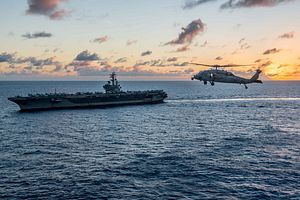Just before the New Year, an article on the website The Daily Caller claimed that “China Targeted U.S. Aircraft Carrier In The South China Sea With Dozens Of ’Carrier Killer’ Missiles” after the July Hague ruling that invalidated many of China’s claims and positions in the South China Sea. After The Daily Caller report, the story was picked up by the websites Newsline and Chinatopix, the latter purporting that “China almost started a war against the United States” during the incident.
But the Chinese news sources cited by these articles do not back up the supposed revelations that China targeted a U.S. aircraft carrier or threatened a major crisis over the Hague ruling.
According to The Daily Caller article:
The People’s Liberation Army (PLA) Rocket Force reportedly targeted the USS Ronald Reagan in the South China Sea with “carrier killer” DF-21D anti-ship ballistic missiles a few days before the Permanent Court of Arbitration in The Hague officially discredited China’s nine-dashed line in a landmark ruling this summer, according to DW News, which cited CCTV.
The article also claimed Chinese media said the United States and China came close to conflict during this period, called it a major crisis, and stated that “China readied its new missiles” in response to the presence of the Ronald Reagan and another U.S. aircraft carrier in the South China sea in the weeks leading up to the Hague ruling.
Taylor Fravel, associate professor of Political Science at MIT and a Mandarin speaker, revealed on Twitter Tuesday that the original Chinese news sources cited in The Daily Caller article and related stories do not make the claims about targeting a U.S. aircraft carrier The Daily Caller and other stories report. He explained that the only July event that the original CCTV news segment mentions is clearly described as an exercise between the Chinese Navy and the Rocket Forces, not an actual military operation, and does not reference the USS Ronald Reagan. Contrary to the assertion that China “readied it new missiles in response” to the actual presence of a U.S. aircraft carrier in the South China Sea, transcripts of the CCTV segment show that it is describing an exercise scenario, not a real-world crisis.
A DW News report, really just a picture caption for a still captured from CCTV, does claim that the CCTV segment reported on “missiles aimed at U.S. aircraft carrier” in a South China Sea conflict, and speculates that missiles mentioned in the CCTV segment are DF-21D anti-ship missiles. But the original CCTV segment did not mention U.S. aircraft carriers at all, and the DW report does not mention the USS Ronald Reagan specifically, so it isn’t clear if the latter was speculating about a generic South China Sea exercise scenario or referring to then-current events.
Reached by email, Professor Fravel explained that he thought the claim that CCTV revealed the deliberate targeting of a U.S. warship was unusual, and tried to investigate the source because it is exceptionally rare for China’s official media to comment on actual military operations. He thought that the specifics about the Ronald Reagan being targeted would make the Chinese story easy to track down. “Given that the original [CCTV and DW] sources at most only support the occurrence of a joint PLAN-PLARF exercise,” Professor Fravel determined, “it is hard to see how the conclusions in The Daily Caller article could be justified based on the available evidence.”
The Daily Caller article concludes with speculation that “De-escalation occurred in the aftermath of the ruling, and China switched to a deterrence stance, reportedly relying on its DF-21D and DF-26 missiles to keep American ships at a distance.” The source of this reporting isn’t provided, nor is it explained how U.S. ships would know they were supposedly under threat from the long-range Chinese missiles — a necessary condition for being deterred by them. In any case, dated public affairs photographs posted on the U.S. Navy’s website show that ships from the U.S. Third Fleet Pacific Surface Action Group, made up of the destroyers USS Momsen, USS Decatur, and USS Spruance, were operating in the South China Sea through July and August and not keeping “at a distance.”
Translating foreign news sources for use in domestic reporting will always pose challenges for both the United States and China. While this story was not picked up and repeated by larger news organizations or wire services, it demonstrates the compounding problem that can result when a news outlet in one country applies speculation or editorializing to reporting that is based on a similarly speculative news source or story from the other. Both the United States and China have pundits, commentators, and news analysis sources of varying quality, and there is risk in conflating their private analyses with the official public positions, policies, and motives of their governments in reporting back to the other domestic audience. The resulting “game of telephone” risks ratcheting tensions in the public sphere based on what private sources think their governments are doing, or should be doing, instead of what the U.S. and Chinese governments are actually doing.

































